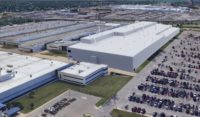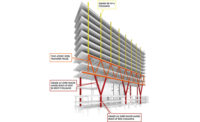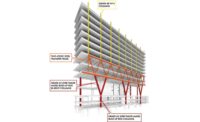The Lower Sioux Indian Community, near Morton, Minn., has a little more than 1,100 residents and 1,473 acres of mostly sandy soil, but it could soon lead the nation in production of hemp-infused construction materials.
Construction is underway at the Lower Sioux Community, also known as the Mdewakanton Tribal Reservation, on a 20,000-sq-ft manufacturing campus in Redwood County, Minn. The Lower Sioux are already growing hemp on their acreage and plan to process it into a construction material made of lime, hemp and water called hempcrete. They plan to use hempcrete to build homes with it for members of the tribe.
"We're still not a fully formed, cohesive, vertically integrated system yet, but we're getting there," says Earl Pendleton, a former elected member of the Lower Sioux Tribal Council, who led the effort to both grow hemp and build a campus with a production facility to produce hemprcrete. "We're finally at the point where we can build with it. And that's when I knew this was the final step, the final stage."
A steel skeleton for the production facility has been erected in the community and contractor Loeffler Construction and Consulting is working to complete the $6.2-million project completed by the end of April. The project is financed by money the community raised from its existing hemp program, sustainability grants and loans.
Hemp's Long Construction History
While hempcrete has been used abroad as a building material for decades, and has been used to make complicated projects in France since the '90s, making it in the U.S. wasn't allowed under federal law until the 2018 farm bill legalized the industrial production of hemp, the portion of cannabis sativa (the marijuana plant) that's been used for hundreds of years in products such as rope, textiles and paper. Way back in 1937, The Marihuana Tax Act effectively outlawed hemp production in the U.S., despite the part of the plant that produces hemp has hardly any tetrahydrocannabinol (THC), the psychoactive chemical in cannabis.
Hemp comes from the same species of plant as marijuana but, from a legal standpoint, "marijuana" refers to cannabis that has more than 0.3% THC by dry weight. Any part of the plant lower in THC content is legally considered hemp. The inner woody core of the hemp plant (shives or hurd) is mixed with a lime-based binder, water and sometimes additional pozzolans to make the building material known as hempcrete or hemp lime.
The mix is a lightweight, self-insulating material that can be formed into blocks, cast-in-place or sprayed between framing cavities to set up like stucco or plaster. Hemp can be cultivated in 90 to 120 days and is able to grow in adverse conditions since it is a weed.
A Cambridge study found that the fibrous plant can absorb around six tons of carbon dioxide per acre during its growth phase, making it a much better option for capturing CO2 than trees.
Building materials are responsible for around 11% of carbon dioxide production worldwide, so alternatives such as mycelium (mushroom roots) and algae are being used in building materials to reduce that number today, but none of these materials have the longevity and track record of long-time, safe and effective use that hemp does.
Before the 1937 act, hemp panels were used in Henry Ford's Model T automobile. Hempcrete was approved for use in residential construction by the International Code Council in October 2022.
The U.S. Hemp Building Association, a U.S. Green Building Council member group that's presented at the Greenbuild Trade Show, is working to get hempcrete and other hemp products approved for use in commercial construction, but is still in the testing phase of its application for the International Building Code, board member Tai Olson, of Chicago-based US Heritage Group, said in the organization's newsletter.
“We’re really just looking for a way to get two elements, thermal rating and fire rating into the commercial building codes,” Olson said.
Hemp Brings a Future
After curing, hempcrete creates a rigid air and water barrier and it's nontoxic and resists mold, fire and infestation. China is the world’s largest producer of hemp, followed by France, but in the U.S. so little of it is produced that building product manufacturers haven't invested in the machinery to process it into hempcrete blocks because most of the farmers raising legal cannabis have already committed to growing breeds of the plant that can be sold to lucrative legal dispensaries. Additionally, many state laws still make it difficult to both grow and process the plant, even though industrial production was legalized under the farm bill.
Many states still ban bank loans for the processing of any cannabis product, for example, but reservations such as the Lower Sioux Community are allowed to make their own laws surrounding such products.
Pendleton, formerly the treasurer of Lower Sioux Indian Community Tribal Council, saw the opportunity hemp provided his community in the early 2010s. The reservation’s Jackpot Junction Casino has been the community's main source of income for the past 35 years, but as the novelty of casino gambling has worn off and the population on the reservation has expanded since 2000, the per capita cut each Lower Sioux family gets from the casino's $30 million yearly profits has shrunk.
About half of the residents in the community don't have full-time homes. Creating an industry that trains the young people of the community in construction, agriculture and the sales aspects of commercial hemp products offered a better future than gambling enterprises, Pendleton thought.
The State of Minnesota ran a hemp products research project through the University of Minnesota system in 2016 that involved growing mainly for research into the properties of the fibrous material and how it could be commercialized. The Lower Sioux jumped at the chance under Pendleton's leadership.
"That's the year I think we first started with a small acreage," he recalls. "At that time, it was going to be tied with a research, higher learning, for research purposes, project but in 2017, it was then allowed for commercial purposes, so we could use it and sell it."
"We sold the green (the cannabis), which was really the only part of the plant that there was a market for at the time and we got a good return that covered our farming costs," Pendleton explains. "We ended up with the stock of the plant, which is the hurd (or shives) and the fiber. We paid for our farming with the sale of the green and that made the hurd basically free."
Construction at the Lower Sioux Community
The Lower Sioux have already built demonstration projects, a shed and a two-room building using wood framing and sprayed-on hempcrete. They process some of their hemp into hempcrete at commercial facilities off the reservation.
"To try to produce it here in the community when we've never farmed any crop in our 80 plus years of existence, that was a big endeavor, by itself," Pendleton says.
There is potential to plant hemp on 300 acres and, at a given time, grow the hemp on between 100 and 200 acres with a common crop rotation. Test seeds came from New Genetics in Colorado and the Dun Agro Hemp Group, a Dutch company with a processing facility in Indiana. Dun Agro is looking to partner with native communities that have the sovereignty to decide to build production facilities in the U.S.
"We already have equipment that's being housed in another facility," said Danny Desjarlais, the community's construction manager for the hemp campus project. "As soon as this campus is done, we'll bring that equipment over and get it set up and hopefully get it up and running, you know, within the first couple of weeks after we move into the building."
Desjarlais was a carpenter who was considering becoming a long-haul trucker before Pendleton brought the idea of hemp production to him.
"Ear was the one that hired me 19 months ago" for the hemp building project, Desjarlais says.
The processing facility will be the first fully integrated hempcrete facility with its own growing operation nearby in the U.S. if it's completed on time in April. By producing and processing their own hemp, the hempcrete block and foam it creates have the potential to be less expensive on the open market than those of producers who are buying the plants elsewhere and then processing them because of the economies of scale that can be achieved by eliminating shipping costs, distributors and, for the overseas producers, import tariffs and fees.






Post a comment to this article
Report Abusive Comment